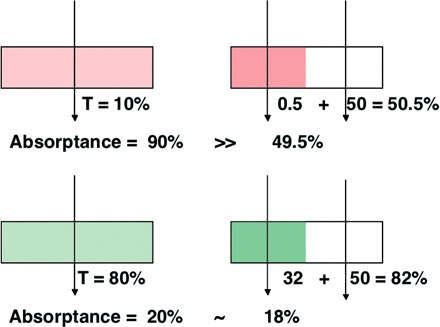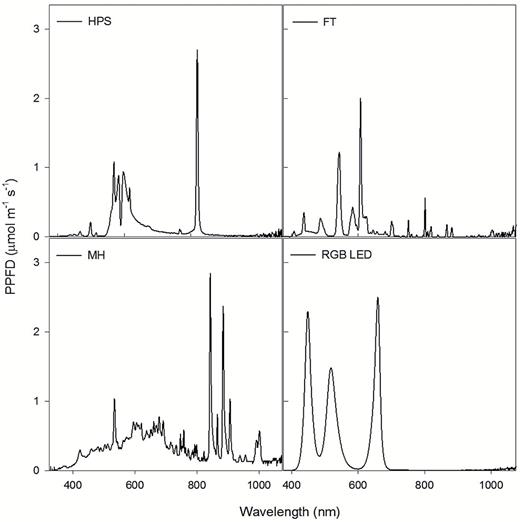I took three different spectrographs tonight at three different canopy levels. Have a look at how deep Far Red penetrates compared to the other spectra. Green not so much, but more than red and blue.
Top canopy
View attachment 5355808
| PPFD (400 - 700 nm) | | 933.97 |
| PPFD FR (701 - 780 nm) | | 158.53 |
| PPFD R (600 - 700 nm) | | 509.43 |
| PPFD G (500 - 599 nm) | | 292.49 |
| PPFD B (400 - 499 nm) | | 131.96 |
| PPFD UV (380 - 399 nm) | | 10.148 |
Mid canopy
View attachment 5355809
| PPFD (400 - 700 nm) | | 76.991 |
| PPFD FR (701 - 780 nm) | | 30.73 |
| PPFD R (600 - 700 nm) | | 41.204 |
| PPFD G (500 - 599 nm) | | 25.191 |
| PPFD B (400 - 499 nm) | | 10.586 |
| PPFD UV (380 - 399 nm) | | 0.7753 |
Bottom canopy
View attachment 5355810
| PPFD (400 - 700 nm) | | 10.312 |
| PPFD FR (701 - 780 nm) | | 10.689 |
| PPFD R (600 - 700 nm) | | 5.8184 |
| PPFD G (500 - 599 nm) | | 3.4398 |
| PPFD B (400 - 499 nm) | | 1.0518 |
| PPFD UV (380 - 399 nm) | | 0.0253 |
And here are the lights and tent that were measured.
View attachment 5355815
Id like to drop a link to one of my favourite posts here on riu since youre onto the same thing: what light gets absorbed by the plants and what travels down thru the cannopy.
Malocan. If you could by chance do a simple test with only a few metering points Of any difference from a fully reflective area vs anything less. Fully reflective as in white or silver floor ceiling and walls vs the normal non reflective floor and ceiling. Facing the meter up of course. Just...
www.rollitup.org
He had similar but contrasting findings. The poster had a spectrometer and a 3500k led light and measured the remaining spectrum puting one, two and three leaves on top of the sensor. The results was quite eye opening but not surprising it youve read up on spectrums; most light absorbed at 680nm leaving lots of greens and far reds.
Both looking at your results and contrasting with Malocans results theres a few things i find interesting:
- in your mid cannopy reading it looks like the blue peak decreased more than the violet peak. But then down in bottom cannopy the violet is almost gone completely with plenty of blue peak left. Seems to defy logic a bit.
- contrast to malocan: he had much more green left than you. 660 was also very clearly missing in the "low cannopy" shots but he didnt have any red sup. Also i dont think he did the exact same thing as you; i think he took a shot of one leaf covering the sensor, then another leaf on top and then a third leaf. The way ive read the thread it seems like rather than sticking the sensor into cannopy he actually covered the sensor with leaves in layers so that you wouldnt have any light sneaking into the sensor from the sides.
It would be very interesting to repeat the test in this way if you have the urge to get science-y with us.
Another thing that may skew results in cannopy measurements would be how close you are to those reflective sides. As in if Mid and low cannopy reading were closer or further away from the reflective sides.
More things: i find it somewhat odd that you have such a symmetric decrease over the spectrum. Especially of the 660 peak. Malocans results 660 dropped off almost as fast as 680nm, here you can clearly see the peak going all the way down to "low cannopy".
His light source was a cob which may have some influence here.
The reason i find it so interesting is due to the concept of "penetration". Ive often scorned it cause i dont think everyone is talking about the same thing: are we talking about buds all the way down or actual light levels or spectrum remaining at the bottom of the cannopy. Some have also argued that penetration is higher with point like lightsources or that you have to have really intense light at the source. As in having a 500w cob would have more P than a 12x12" board of 500w.
Having the monos come thru so clear in your test compared to how much red is absorbed in malocans tests is interesting in this context.
Oh, prawn youve made me feel like "ye olden days" of riu. Please lets have a bit of fun with this and make this thread to a xmas present to all of us and lets get some more data. Im getting popcorn on for this one.




















